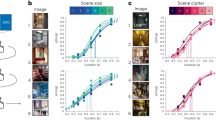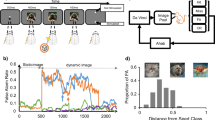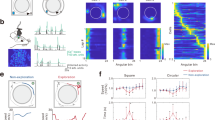Abstract
Brain–machine interfaces1,2 use neuronal activity recorded from the brain to establish direct communication with external actuators, such as prosthetic arms. It is hoped that brain–machine interfaces can be used to restore the normal sensorimotor functions of the limbs, but so far they have lacked tactile sensation. Here we report the operation of a brain–machine–brain interface (BMBI) that both controls the exploratory reaching movements of an actuator and allows signalling of artificial tactile feedback through intracortical microstimulation (ICMS) of the primary somatosensory cortex. Monkeys performed an active exploration task in which an actuator (a computer cursor or a virtual-reality arm) was moved using a BMBI that derived motor commands from neuronal ensemble activity recorded in the primary motor cortex. ICMS feedback occurred whenever the actuator touched virtual objects. Temporal patterns of ICMS encoded the artificial tactile properties of each object. Neuronal recordings and ICMS epochs were temporally multiplexed to avoid interference. Two monkeys operated this BMBI to search for and distinguish one of three visually identical objects, using the virtual-reality arm to identify the unique artificial texture associated with each. These results suggest that clinical motor neuroprostheses might benefit from the addition of ICMS feedback to generate artificial somatic perceptions associated with mechanical, robotic or even virtual prostheses.
This is a preview of subscription content, access via your institution
Access options
Subscribe to this journal
Receive 51 print issues and online access
$199.00 per year
only $3.90 per issue
Buy this article
- Purchase on Springer Link
- Instant access to full article PDF
Prices may be subject to local taxes which are calculated during checkout




Similar content being viewed by others
References
Lebedev, M. A. & Nicolelis, M. A. Brain-machine interfaces: past, present and future. Trends Neurosci. 29, 536–546 (2006)
Nicolelis, M. A. & Lebedev, M. A. Principles of neural ensemble physiology underlying the operation of brain-machine interfaces. Nature Rev. Neurosci. 10, 530–540 (2009)
Chapin, J. K., Moxon, K. A., Markowitz, R. S. & Nicolelis, M. A. L. Real-time control of a robot arm using simultaneously recorded neurons in the motor cortex. Nature Neurosci. 2, 664–670 (1999)
Velliste, M., Perel, S., Spalding, M. C., Whitford, A. S. & Schwartz, A. B. Cortical control of a prosthetic arm for self-feeding. Nature 453, 1098–1101 (2008)
Moritz, C. T., Perlmutter, S. I. & Fetz, E. E. Direct control of paralysed muscles by cortical neurons. Nature 456, 639–642 (2008)
Wessberg, J. et al. Real-time prediction of hand trajectory by ensembles of cortical neurons in primates. Nature 408, 361–365 (2000)
Taylor, D. M., Helms-Tillery, S. I. & Schwartz, A. B. Direct cortical control of 3D neuroprosthetic devices. Science 296, 1829–1832 (2002)
Serruya, M. D., Hatsopoulos, N. G., Paninski, L., Fellows, M. R. & Donoghue, J. P. Instant neural control of a movement signal. Nature 416, 141–142 (2002)
Carmena, J. M. et al. Learning to control a brain-machine interface for reaching and grasping by primates. PLoS Biol. 1, e42 (2003)
Johansson, R. S. & Westling, G. Roles of glabrous skin receptors and sensorimotor memory in automatic control of precision grip when lifting rougher or more slippery objects. Exp. Brain Res. 56, 550–564 (1984)
Flanagan, J. R. & Wing, A. M. Modulation of grip force with load force during point-to-point arm movements. Exp. Brain Res. 95, 131–143 (1993)
James, T. W., Kim, S. & Fisher, J. S. The neural basis of haptic object processing. Can. J. Exp. Psychol. 61, 219–229 (2007)
Chatterjee, A. Aggarwal, V. Ramos, A., Acharya, S. & Thakor, N. V. A brain-computer interface with vibrotactile biofeedback for haptic information. J. Neuroeng. Rehabil. 4, 40 (2007)
Kaczmarek, K., Webster, J., Bach-y-Rita, P. & Tompkins, W. Electrotactile and vibrotactile displays for sensory substitution systems. IEEE Trans. Biomed. Eng. 38, 1–16 (1991)
Marasco, P. D., Schultz, A. E. & Kuiken, T. A. Sensory capacity of reinnervated skin after redirection of amputated upper limb nerves to the chest. Brain 132, 1441–1448 (2009)
O’Doherty, J. E., Lebedev, M. A., Hanson, T. L., Fitzsimmons, N. A. & Nicolelis, M. A. A brain-machine interface instructed by direct intracortical microstimulation. Front. Integr. Neurosci. 3, 20 (2009)
Richer, F., Martinez, M., Robert, M., Bouvier, G. & Saint-Hilaire, J. M. Stimulation of human somatosensory cortex: tactile and body displacement perceptions in medial regions. Exp. Brain Res. 93, 173–176 (1993)
London, B. M., Jordan, L. R., Jackson, C. R. & Miller, L. E. Electrical stimulation of the proprioceptive cortex (area 3a) used to instruct a behaving monkey. IEEE Trans. Neural Syst. Rehabil. Eng. 16, 32–36 (2008)
Romo, R., Hernandez, A., Zainos, A. & Salinas, E. Somatosensory discrimination based on cortical microstimulation. Nature 392, 387–390 (1998)
Fitzsimmons, N. A., Drake, W., Hanson, T. L., Lebedev, M. A. & Nicolelis, M. A. Primate reaching cued by multichannel spatiotemporal cortical microstimulation. J. Neurosci. 27, 5593–5602 (2007)
Lederman, S. J. & Klatzky, R. L. Hand movements: a window into haptic object recognition. Cognit. Psychol. 19, 342–368 (1987)
Lebedev, M. A. et al. Cortical ensemble adaptation to represent velocity of an artificial actuator controlled by a brain-machine interface. J. Neurosci. 25, 4681–4693 (2005)
Li, Z. et al. Unscented Kalman filter for brain-machine interfaces. PLoS ONE 4, e6243 (2009)
Lebedev, M. A., Denton, J. M. & Nelson, R. J. Vibration-entrained and premovement activity in monkey primary somatosensory cortex. J. Neurophysiol. 72, 1654–1673 (1994)
Liu, Y., Denton, J. M. & Nelson, R. J. Neuronal activity in primary motor cortex differs when monkeys perform somatosensory and visually guided wrist movements. Exp. Brain Res. 167, 571–586 (2005)
Cisek, P. & Kalaska, J. F. Neural correlates of mental rehearsal in dorsal premotor cortex. Nature 431, 993–996 (2004)
Graziano, M. S., Cooke, D. F. & Taylor, C. S. Coding the location of the arm by sight. Science 290, 1782–1786 (2000)
Maravita, A. & Iriki, A. Tools for the body (schema). Trends Cogn. Sci. 8, 79–86 (2004)
Tkach, D., Reimer, J. & Hatsopoulos, N. G. Observation-based learning for brain-machine interfaces. Curr. Opin. Neurobiol. 18, 589–594 (2008)
Dushanova, J. & Donoghue, J. Neurons in primary motor cortex engaged during action observation. Eur. J. Neurosci. 31, 386–398 (2010)
Acknowledgements
We thank D. Dimitrov for conducting the animal neurosurgeries; G. Lehew and J. Meloy for building brain implants; J. Fruh for rendering the virtual-reality monkey arm; T. Phillips, L. Oliveira and S. Halkiotis for technical support; and E. Thomson and Z. Li for comments. This research was supported by DARPA (award N66001-06-C-2019), TATRC (award W81XWH-08-2-0119), the NIH (award NS073125), NICHD/OD (award RC1HD063390) and NIH Director’s Pioneer Award DP1OD006798, to M.A.L.N. The content is solely the responsibility of the authors and does not necessarily represent the official views of the Office of the NIH Director or the NIH.
Author information
Authors and Affiliations
Contributions
J.E.O’D., M.A.L. and M.A.L.N. designed experiments, analysed data and wrote the paper; J.E.O’D., M.A.L., P.J.I. and K.Z.Z. conducted experiments; and S.S. and H.B. developed the virtual-reality monkey arm.
Corresponding author
Ethics declarations
Competing interests
The authors declare no competing financial interests.
Supplementary information
Supplementary Figures
This file contains Supplementary Figures 1-7 with legends. (PDF 3026 kb)
Supplementary Movie 1
This movie sequence depicts monkey M performing task IV in HC mode. Annotations are provided during the freeze frames. The audio track is the spiking activity of a single M1 neuron; ICMS pulses can be completion of a trial and the delivery of a juice reward. Please note that the monkeys could not hear the ICMS pulses or neural activity; these sounds are included for the benefit of the viewer. (MOV 11640 kb)
Supplementary Movie 2
This movie depicts the same sequence as Supplementary Movie 1 but for BC. Please note that the monkeys could not hear the ICMS pulses or neural activity; these sounds are included for the benefit of the viewer. (MOV 14860 kb)
Supplementary Movie 3
This movie sequence depicts monkey M performing task V in HC. Please note that the monkeys could not hear the ICMS pulses or neural activity; these sounds are included for the benefit of the viewer. (MOV 14763 kb)
Supplementary Movie 4
This movie depicts the same sequence as Supplementary Movie 3 but for BC. Please note that the monkeys could not hear the ICMS pulses or neural activity; these sounds are included for the benefit of the viewer. (MOV 16711 kb)
Rights and permissions
About this article
Cite this article
O’Doherty, J., Lebedev, M., Ifft, P. et al. Active tactile exploration using a brain–machine–brain interface. Nature 479, 228–231 (2011). https://doi.org/10.1038/nature10489
Received:
Accepted:
Published:
Issue Date:
DOI: https://doi.org/10.1038/nature10489
This article is cited by
-
Brain control of bimanual movement enabled by recurrent neural networks
Scientific Reports (2024)
-
May the force be with you: exploring force discrimination in chimpanzees using the force-feedback device
Primates (2024)
-
Neuroprosthetics: from sensorimotor to cognitive disorders
Communications Biology (2023)
-
Touch, press and stroke: a soft capacitive sensor skin
Scientific Reports (2023)
-
Spatio-temporal activation patterns of neuronal population evoked by optostimulation and the comparison to electrical microstimulation
Scientific Reports (2023)
Comments
By submitting a comment you agree to abide by our Terms and Community Guidelines. If you find something abusive or that does not comply with our terms or guidelines please flag it as inappropriate.



